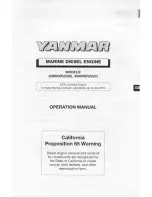
14
Glowplug leads
Fig.14
Switch should have
sufficient capacity.
The plug leads are fitted with special snap-on connectors
that ensure firm contact with O.S. plug. They are a "click" fit
and are not suitable for use with most other makes of
glowplug.
The earth (ground) lead is fitted with a plug terminal which
should be connected to the engine by means of one of the
mounting screws.
Make sure that no part of the wiring touches the cylinder
head or cooling fins.
Keep wiring away from the fuel tank where it might cause a
fire in the event of a short-circuit.
Fig.15
Install Ni-Cd battery in the fuselage, and switch on or off by means
of transmitter. (On-board battery)
1.2 volt Ni-Cd battery with
more than 6 Ah capacity.
If glowplug leads are extended
together as a single cable, use heavier
wire, e.g. 2.0 mm multi-strand copper
core as supplied for earth lead.
2
2
2.0mm
Earth (ground)
lead
Fasten to the
motor mount.
Glowplug re-heat
Under normal conditions, the FF-320 will idle sufficiently
slowly with the throttle closed to permit a safe landing
approach. However, if conditions (atmospheric, fuel, tank
location etc.) are unfavorable, there may be a tendency for
one cylinder to cease firing if the engine is throttled down to a
very low idling speed. This can be prevented by installing a
small on-board Ni-Cd battery which will automatically re-heat
the glowplugs when the engine is throttled down to idling
speed (Fig.14). A suitable switch should be installed so that it
is actuated by the throttle servo only when the engine is
throttled down. Safe idling speeds of less than 1,800 rpm may
be obtained in this way and without undue drain on the
battery.
Model engine fuel is poisonous. Do not allow it to
come into contact with the eyes or mouth. Always
store it in a clearly marked container and out of the
reach of children.
Model engine fuel is also highly flammable. Keep it
away from open flame, excessive heat, sources of
sparks, or anything else which might ignite it. Do not
smoke, or allow anyone else to smoke, near to it.
Reminder!
Fuel
The FF-320 should be operated on a methanol based fuel
containing not less than 18% (volumetric) castor oil, or a top
quality synthetic lubricant (or a mixture of both), plus a small
percentage (5-20%) of nitromethane for improved flexibility
and power.
FUEL AND LUBRICATION
15
Lubrication
All parts of the FF-320 are automatically lubricated by the oil
content of the fuel mixture.
The crankcase breather hole is located at the side of the
engine and is fitted with a brass nipple. (See photo 3 on page
7.) Fit a length of silicone tubing of approx. 2.5-3mm I.D. to
this nipple to conduct away the small amount of oil that
escapes through the breather.
Make a habit of draining out the excess oil in the crankcase
at the end of each flying session. Leaving contaminated oil in
the crankcase for a long time will cause rust. Also, residual
castoroil will tend to solidify and lock the engine. Inject
corrosion-inhibiting oil into the crankcase to neutralize the
effects of any remaining contaminants.
Fig.16
Photo. 4
Carburetor
Rear Housing
Drain Nipple
Drain Plug
2.5mm Silicone tubing
At the conclusion of the flying session, drain out the excess
oil in the crankcase by removing the drain plug. While
running the engine, the drain plug should always be installed.
(See Photo 4 and Fig. 16)
STARTING
Precautions
For safety, please observe the following instructions before
starting the engine.
Start the engine by turning the propeller counter-clockwise
(i.e. normal running direction).
Do not start the engine with the throttle fully opened,
otherwise the model will tend to move forward suddently due
to the strong thrust of the propeller. Hold both wings of the
model when starting the engine.
Do not carry out carburetor adjustments (except needle-
valve adjustment) while engine is running.
Use a high-torque electric starter.
Starting procedure is as follows:
Open the needle-valve 3 to 3.5 turns
from the fully closed position (Fig.17).
1.
open 3 to 3.5 turns.
Fig.17
Make sure that glowplugs are not connected to the battery.
Do not heat the glowplugs while priming. (Fig.18).
2.
Do not connect the battery to
the glowplugs while priming.
Fig.18



































